Employee productivity measures how well employees do their jobs compared to the time and effort they put in.
You can calculate employee productivity by tracking output against goals, monitoring completed tasks, and the quality of work.
But, it can be hard to measure and improve the productivity of remote workers and keep them focused in modern work settings.
This article helps you:
- Spot why productivity and interest drop and learn ways to lift them
- Navigate the mix of office and remote work smoothly
- Keep a balance between team well-being and work goals
- Handle work interruptions with ease
- Keep up with tech changes without falling behind
Importance of employee productivity for professional services companies
Here are six reasons why employee productivity is important for professional services companies:
- Maximizing billable hours: Professional services companies that charge by the hour can earn more if they boost employee productivity.
This approach lets teams complete more projects quickly without extra costs.
- Delivering client satisfaction: When employees work productively, they deliver services efficiently, which keeps clients happy. Fast, high-quality service can improve reputation and build client loyalty.
- Achieving competitive advantage: In a crowded market, the productivity of a professional services team can make a company stand out.
A productive team often delivers better results quickly, gaining a competitive advantage.
- Maintaining profit margins: The costs of hiring and retaining the best talent in professional services are high. Maximizing productivity can keep profit margins healthy.
- Optimizing resource allocation: Professional services companies frequently face variable workloads. When productivity is high, they can allocate resources more effectively so no one is idle or overworked.
- Improving employee morale and retention: A productive work environment streamlines workflows and motivates team members.
This sense of value can boost morale, which typically leads to lower turnover rates.
Ways to improve employee productivity
We’ll look at ten practical ways to increase employee productivity.

1. Use time-tracking apps
Time tracking means recording and analyzing the amount of time employees spend on tasks.
But why is time tracking important for productivity?
Here are some key reasons:
- Improves time management: When employees track their work hours, they are more aware of allocating their time.
This awareness helps them pinpoint and reduce time spent on less important tasks.
- Boosts time management skills: Employees can fine-tune their scheduling skills with the data from time tracking. They can learn to prioritize tasks and manage their workload more effectively.
- Cuts down on distractions: Being mindful of the ticking clock, employees tend to maintain focus on the task at hand.
Time tracking helps them minimize distractions and reduce unproductive activities.
You can track time manually, but time-tracking apps automate the process, making it easier and more accurate.
Time-tracking apps are digital tools that help you measure employee productivity.
Time-tracking apps like Toggl Track come with features like
- One-click timer
- Detailed reporting (summary, weekly, detailed reports)
- Integrations with project management tools like Toggl Plan
- Profitability and employee performance metrics
Look how easy it is to start and stop the timer in Toggl Track.
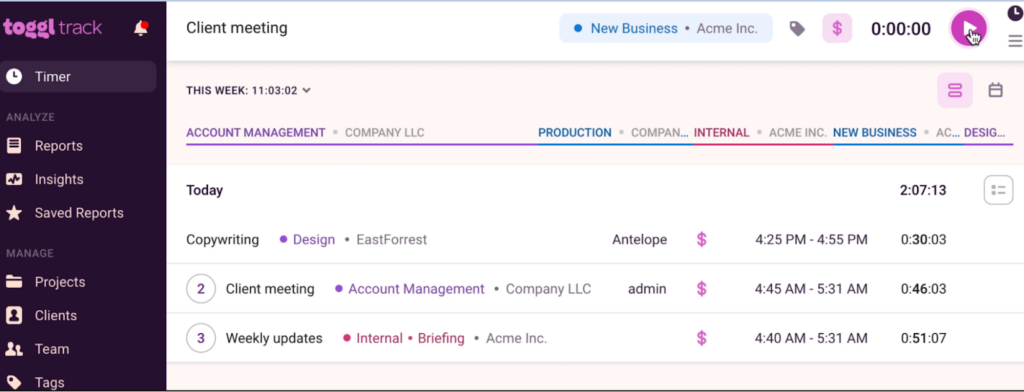
Also, Toggl Track integrates seamlessly with Toggl Plan, so you can easily track tasks and projects right from your project management tool.
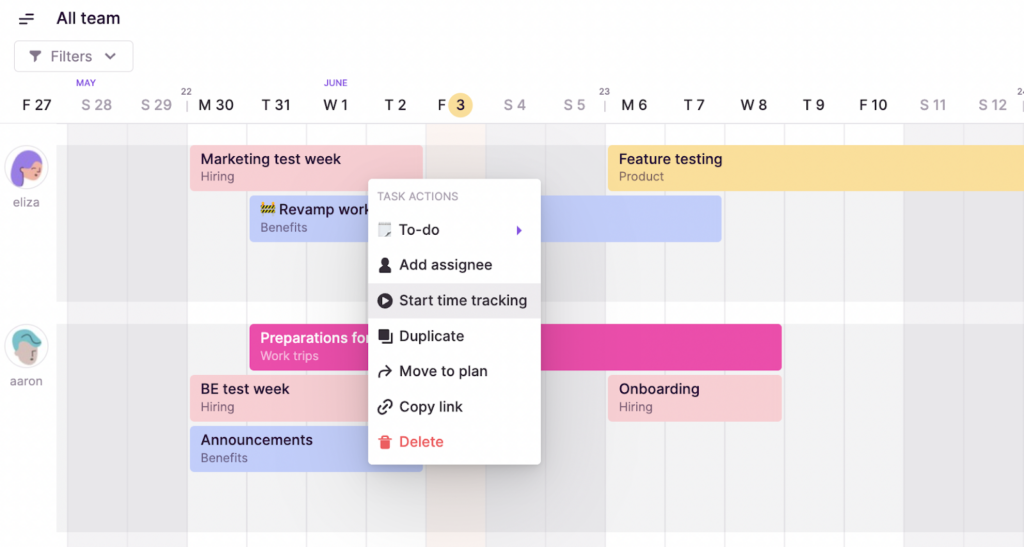
Further reading: 11 Best Employee Time Tracking Software & Apps
2. Optimize resource allocation
Capacity planning is about figuring out how much work your company can do so you can meet demand.
For professional services, it means matching what your employees are good at and when they can work with the schedule and needs of your projects.
Capacity planning helps you ensure all your team members have the right amount of work. Neither too much nor too little.
How does capacity planning influence productivity?
- Optimizes resource utilization: Capacity planning helps you balance workloads to avoid too little or too much work for each team member.
- Prevents burnout with optimal resource allocation: By avoiding overbooking, capacity planning helps maintain employee well-being. Healthy employees tend to be productive employees.
- Enhances work quality: Employees who aren’t overextended can do their best work and make fewer mistakes.
Capacity planning tools like Toggl Plan can help you foster all these benefits.
These tools offer features like visual timelines, workload heatmaps, and availability overviews.
Toggl Plan’s Availability Overview panel lets you see exactly how much work your employees have and if there’s room for more.
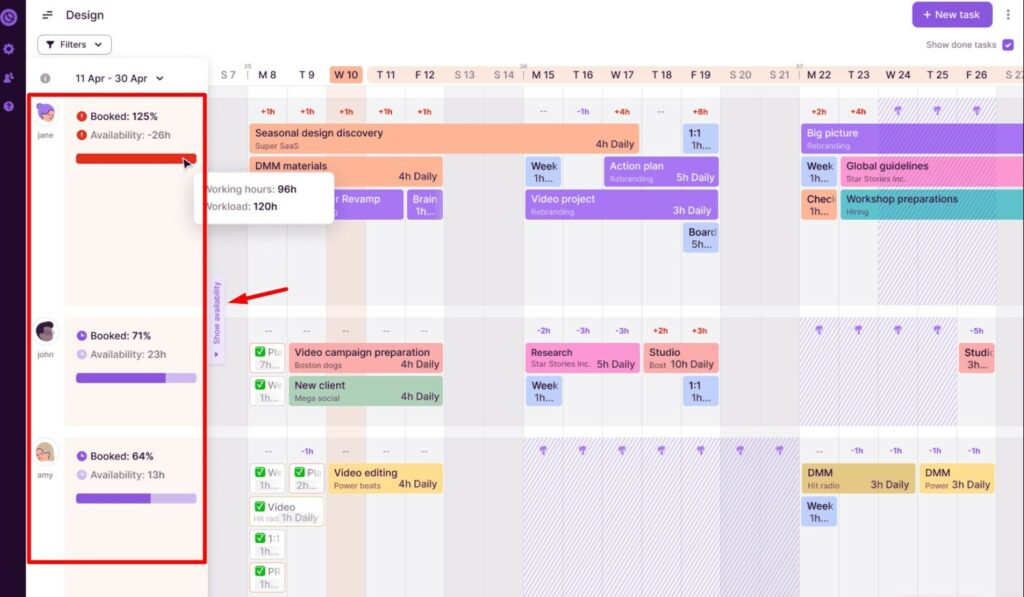
Here’s how the Availability Overview feature improves employee productivity:
- It gives a simple and visual overview of your team members’ booked and available hours
- It lets you quickly identify over or under-booked employees so you can balance workloads.
- It removes the guesswork from your project scheduling.
3. Use project scheduling tools
Project scheduling involves planning, organizing, and creating a timeline for the completion of various tasks in a project.
When scheduling a project, you estimate how much time tasks should take and who will work on each task. Sometimes it can be difficult to estimate how long a task will take if you aren’t an expert yourself, so it’s best to involve the team or experts in your planning.
Project scheduling is essential for improving employee engagement because:
- It gives everyone a clear plan to follow
- It helps keep the team focused and on track
- It makes sure you finish work on time
- It prevents last-minute rushes by balancing workloads
Project scheduling tools make scheduling easier and more efficient.
These tools help you create, track, and manage your project’s schedule, set deadlines, assign tasks, and track progress.
Toggl Plan has many scheduling features that boost productivity.
For example, Toggl Plan’s Project Timeline feature outlines your project’s plan on a timeline.
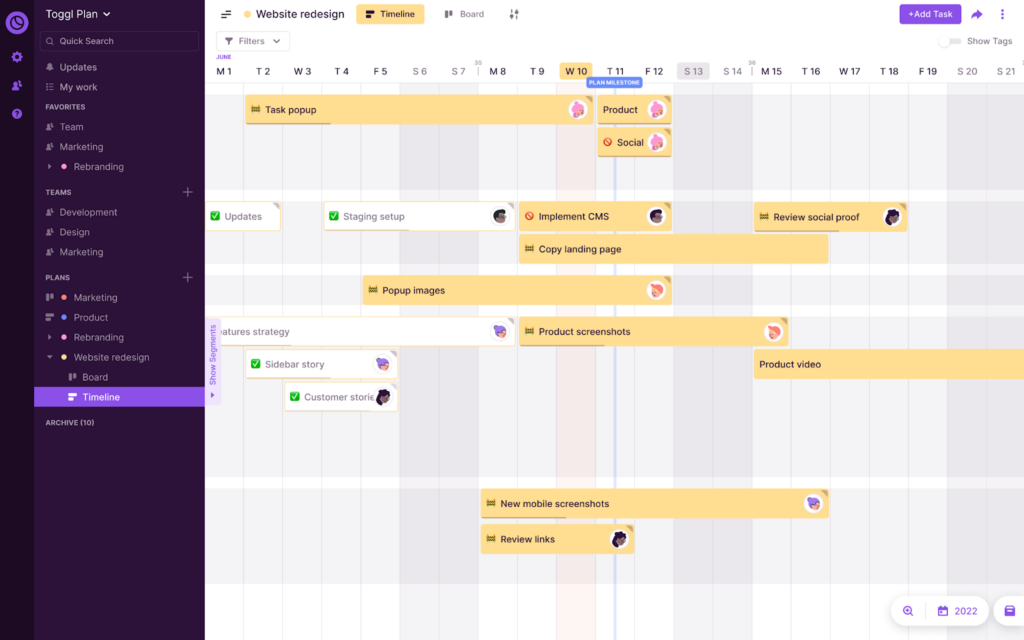
This clear view of your schedule:
- Shows the whole project in one place so you can see how everything fits together
- Makes it easy to adjust deadlines and tasks
- Helps you see what’s coming next so you can prepare
Toggl Plan also has Project Boards, where you can post and move around your project tasks. Boards are useful because:
- They let you organize tasks to make sense for your project
- You can see upcoming, in progress, and completed tasks at a glance
- They let you visually organize employee work and see updates in real-time
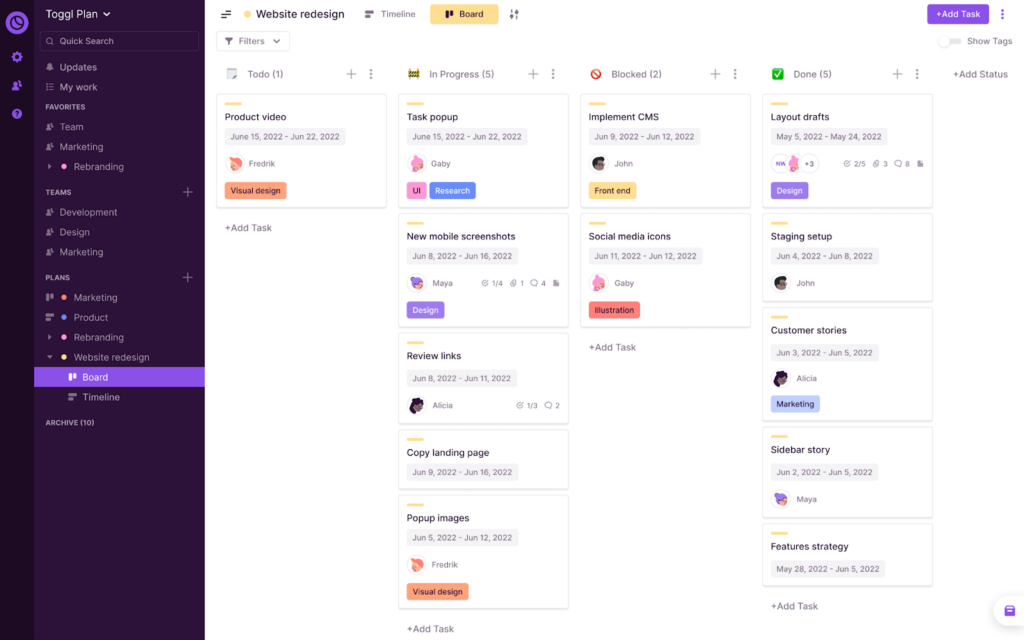
4. Provide training on time management
Time management means organizing and dividing your time between different activities.
Or, simply put, deciding what to do and when to do it.
Time management is critical to improve productivity because:
- It helps employees focus on the right things at the right time
- It cuts down on wasted time and helps get more done
- It reduces stress because employees aren’t rushing to meet deadlines
Time management strategies like focus time or the Pomodoro technique can improve employee productivity.
Focus time is a time block you put aside for focused work without interruptions. It usually lasts for two or more hours, and the goal is to remove distractions and boost productivity.
The Pomodoro technique is another time management strategy that involves working in focused 25-minute intervals separated by short 5-minute breaks.
Time management tools also help you improve productivity, keep track of your time, and plan your day.
They can be simple to-do lists or complex software that helps you manage every minute of your workday.
These tools can include:
- Calendars and planners to schedule your tasks
- Apps that block distractions while you’re working
- Alarms and reminders to keep you on track
5. Maintain a healthy workload
Workload management means making sure employees have the right amount of work, not too much and not too little.
When done right, workload management can increase your team’s productivity. Here’s why:
- It reduces employee overwhelm, which can cause stress and burnout
- It helps team members finish work on time
- It lets employees focus better on a manageable set of tasks
Managing workloads on your own is difficult. But, with a workload management tool, the process is much easier and accurate.
Workload management software helps you quickly see and adjust your team’s tasks.
These tools often include features for planning, tracking, and balancing who does what and when.
Let’s look at three of Toggl Plan’s most helpful features for managing workloads and increasing productivity:
- The Team Timeline: On this timeline, you can see each team member’s tasks. You can spot who has too much work and who might need more. Also, you can rearrange tasks to balance workloads.
- Timesheet approvals: You can review, reject, or approve employee timesheets in Toggl Track to ensure accurate time records.
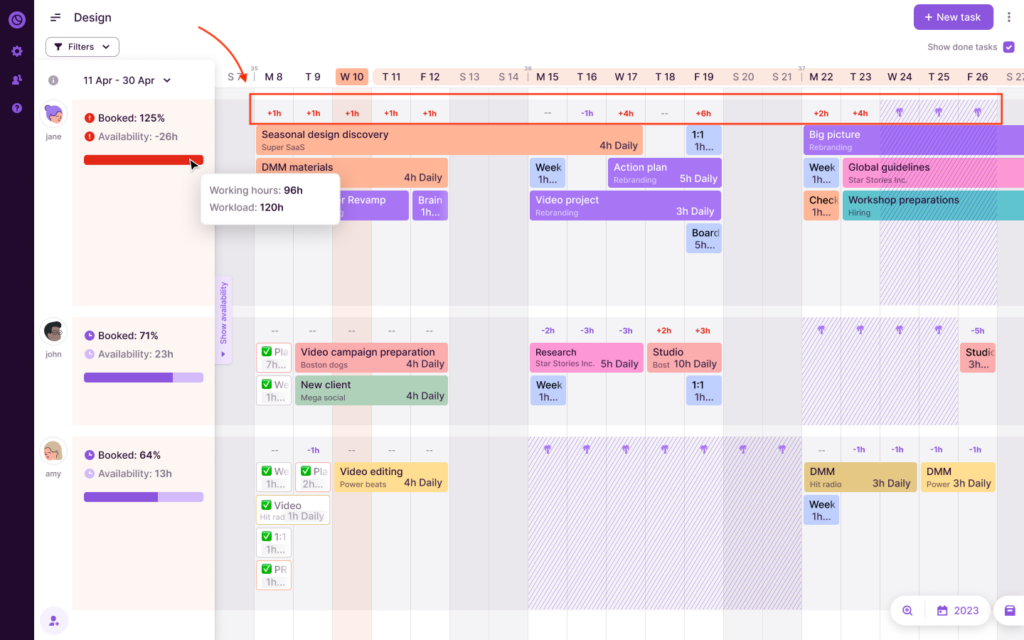
- The Availability Panel: This feature helps you prevent overbooking. You can quickly see when team members are available or too busy so you can improve overall productivity.

6. Encourage regular breaks
Time off is when employees take a break from work. It’s their personal time to rest, relax, or do anything outside of work.
You may be wondering how taking time off helps improve workforce productivity.
Time off lets employees recharge and come back to work with more energy and focus.
Employee time-off tracking software helps you track when and how much time off your employees take.
By tracking time off, you make sure everyone takes their breaks and can plan for coverage while they’re away.
We at Toggl are aware of the importance of taking time off. That’s why we’ve made it super simple to track.
Toggl Plan offers a Time Off feature, and here’s what it can do:
- Plan ahead: Employees can schedule their time off in advance.
- Visibility: Time off is visible on the team’s timeline, which helps you plan workloads and deadlines.
- Balance workload: With access to everyone’s planned time off, you can assign tasks based on your team’s availability and capacity.

7. Invest in employee training
Prepared employees are generally more productive.
In fact, according to new research from SHRM Research and TalentLMS, when asked about job training, 55% of workers revealed that they need more training to do their jobs more effectively.
Professional development plans can help train employees and improve their productivity.
A professional development plan is a tailored list of clear goals, skills, and training employees need for career progress.
Professional development plans set clear objectives for professional growth and improve workplace productivity in many ways:
- When employees learn new skills or polish existing ones, they perform better.
- With a clear map of their career growth, employees tend to be more engaged and motivated.
- Trained employees are likely to feel valued and invested in, which can make them more productive.
8. Encourage asynchronous communication
Asynchronous communication is a flexible type of communication that improves productivity. It lets team members:
- Respond when most convenient for them, without interrupting their workflow.
- Have time to think through their responses, which can improve the quality of communication.
- Work across different time zones without the need for everyone to be online at the same time.
- Reduce the pressure and stress of immediate response, enhancing overall job satisfaction.
In Toggl Plan, you can comment on tasks, mention team members, attach files, and create checklists asynchronously.
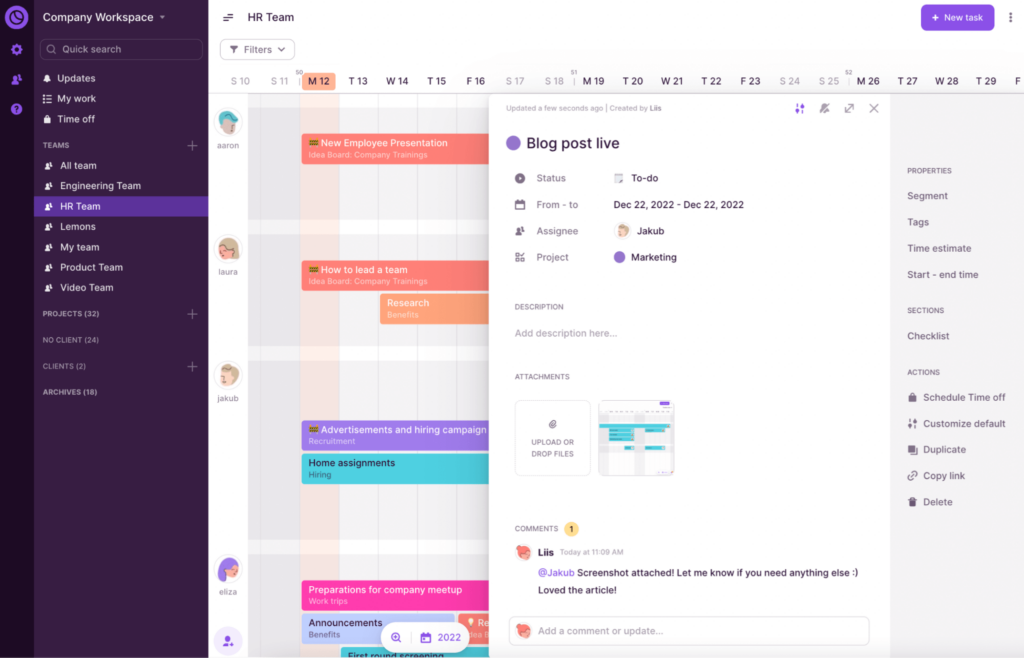
Toggl Plan’s asynchronous communication tools ensure effective communication and help you:
- Keep all relevant information and communication in one place linked to the specific task.
- Keep everyone in the loop and the project moving forward without synchronous meetings.
- Keep a discussion history that provides context and reduces the need for repetitive communication.
9. Try flexible work
Flexible work means employees can choose their working hours, workspace, and work patterns.
According to a Gartner survey, 43% of respondents revealed that they are more productive when they have flexible working hours.
Why should you make flexible work part of your company’s culture?
- Autonomy: Employees choose when and where they work best, which makes them more focused and efficient.
- Less burnout: Flexible schedules can prevent burnout and maintain consistent productivity levels.
- Job satisfaction: Flexibility can increase job satisfaction, which is closely linked to higher productivity.
- Talent retention: Employees who value work-life balance and mental health are more likely to stay within the company.
10. Avoid micromanagement
Micromanagement is a management style where a manager closely observes and controls the work of their subordinates.
In the short term, micromanagement might increase productivity, as employees may work more efficiently under close supervision to meet the exact expectations of the manager.
However, it also has the following negative impact:
- Reduced employee morale: Constant oversight leads to feelings of distrust and a lack of confidence among employees. As a result, morale and job satisfaction decrease.
- Discourages innovation and creativity: Employees are less inclined to take bold, creative steps and risk mistakes with someone constantly watching over their shoulders.
- Increased stress and burnout: The pressure of constant monitoring can lead to increased stress levels. In turn, high stress can result in burnout and higher turnover rates.
- Dependency on the manager: Employees become dependent on their managers for making decisions. As a result, work slows down. And prevents employees from working independently and developing critical skills.
Over time, the negative effects of micromanagement lead to a decline in overall productivity.
Conclusion
The bottom line is that employee productivity is a big thing; by now, you probably know how to improve it.
You’ve learned how Toggl Plan can help you and your team do more and grow the business. Why not sign up for a free Toggl Plan account and see it in action?
Work tools to elevate your productivity – apps for incredibly simple time tracking and effective project planning.
![10 Best Capacity Planning Software & Tools [2024]](images/capacity-planning-tools-112x67.jpg)
![11 Best Project Scheduling Software for 2023 [with Comparison]](images/project-scheduling-software-112x59.jpg)



![How To Improve Employee Productivity – 10 Tested Ways [2024]](images/employee-productivity-673x404.jpg)
